#Creature codex challenge arts
Explore tagged Tumblr posts
Text

“If the Manolo Blahnik fits.”
Fearsome little Mothman.
#Codex Art Challenge#Creature Codex Art Challenge#Creature Codex Tober#Creature codex challenge#Creature codex challenge arts#Codex creature arts#Fanarts Mothman#fearsome creatures#fearsome Mothman#fearsome critters#fearsome creatures of the dark#Mothman arts#Codex fearsome critters of the dark#Fearsome critters Mothman#Mothman October#October Mothman#Mothman fearsome October#Mothman fanarts#Mothman#mothman tober#Mothman fearless#mothman art#Mothman fan art portrait#Mothman portraits#Mothman full portrait#Mothman full fan arts#Mothman full portrait fan arts#Mothman fan art portrait (full page)#Mothman weekend#Mothman spooky
2 notes
·
View notes
Text
Announcing the Creature Codex Art Challenge!

Inspired by a conversation with @doomboy911 . I figure that, with almost 1900 monsters in the Creature Codex, there's enough fodder for a full 30 Day Art Challenge.
The categories are chosen so that they represent a wide variety of monsters, and are relatively easy to find via the Index and the tagging system. I will be following the #codexartchallenge tag, and will be reblogging stuff that people post.
#codexartchallenge#creature codex#art challenge#30 day challenge#30 day art challenge#creature design#monster design#monster art#creature art
86 notes
·
View notes
Text

Theme
Fey (Knocker) Prompt list Creature codex Art Challenge
Commentary
Heh heh knocker. I want to keep learning different styles so for this I made a tile piece you might find in a exploration focused game. I was going to complicate the tiles but the I got consumed with the stardew valley update. Great eyes, great mouth very happy overall.
Palette picked
#Fey#Knocker#codexartchallenge#pixel art#year of art#year of art 2024#Creature codex art challenge#universalis 42
9 notes
·
View notes
Text
The Spellweaver’s Grimoire
The Spellweaver’s Grimoire is one of the most revered and mysterious artifacts in the magical world of Enchancia. Created by Aelric Spellbound, the founder of the Spellbound lineage, it is not merely a book but a living repository of magical knowledge, bound by enchantments that evolve with each generation of the family. The Grimoire is considered the heart of the Spellbound legacy, holding secrets and spells that have shaped the course of magic for centuries.
Origins of the Grimoire
The creation of the Spellweaver’s Grimoire dates back to the Age of Arcane Awakening, a tumultuous period when magic was feared and misunderstood. Aelric Spellbound, a visionary mage, sought to bridge the gap between magic and humanity by creating a tome that would preserve the balance between power and responsibility.
Legend has it that Aelric spent decades crafting the Grimoire, drawing upon his deep connection to elemental spirits and his understanding of magical harmony. He infused it with spells that were not only powerful but also designed to work in harmony with nature and human intent. The Grimoire was enchanted with self-writing magic, allowing it to record new spells and insights from each Spellbound who contributed to its pages.
Physical Description
The Spellweaver’s Grimoire is a massive tome bound in dark emerald leather, its cover embossed with the family crest—a phoenix rising from intertwining vines. The pages are made from an enchanted material that resists decay, glowing faintly when touched by someone of Spellbound blood.
The book is locked with a magical clasp that can only be opened by those deemed worthy. When unworthy individuals attempt to open it, they are met with harmless but humiliating enchantments—such as being temporarily turned into a harmless creature or covered in glittering magical dust.
Magical Properties
The Grimoire is more than just a collection of spells—it is a sentient artifact imbued with Aelric’s essence. It has several unique properties:
Adaptive Spells: The spells within the Grimoire evolve over time, adapting to new magical challenges and incorporating innovations from its users.
Selective Access: Only those who demonstrate balance in their intentions can access its most powerful sections. Even members of the Spellbound family must prove themselves worthy.
Guiding Voice: The Grimoire occasionally communicates with its wielder through whispers or written messages on blank pages, offering advice or warnings.
Elemental Resonance: The book reacts strongly to elemental magic, amplifying spells cast by those aligned with their elemental affinity.
Notable Sections
The Grimoire is divided into several sections, each focusing on a different aspect of magic:
The Elemental Codex: A compendium of spells tied to earth, air, fire, and water magic.
The Weaving Arts: Instructions for creating complex enchantments that blend multiple schools of magic.
The Healing Pages: Spells for restoration and purification, contributed by healers like Esmara Spellbound.
The Shadow Wards: Defensive spells designed to protect against dark magic and corruption.
The Prophetic Verses: Cryptic prophecies that foretell significant events in the magical world.
Role in Family History
Throughout history, the Spellweaver’s Grimoire has played a pivotal role in shaping the destiny of the Spellbound family:
During times of war, it provided protective enchantments that shielded entire villages from harm.
In eras of peace, it served as a guide for teaching younger generations about balance and responsibility.
When Thalion Spellbound attempted forbidden experiments, it was the Grimoire’s warnings that ultimately led him to abandon his dangerous pursuits.
Winifred often referred to the Grimoire as "the soul of our family," emphasizing its importance in maintaining their legacy. Goodwyn valued it as both a tool for heroism and a reminder of their duty to protect Enchancia.
Cedric’s Connection to the Grimoire
As a child, Cedric was fascinated by the Grimoire but struggled to unlock its deeper secrets due to his insecurities and impatience. He often spent hours poring over its pages, hoping to find spells that would help him prove himself worthy of his parents’ expectations.
It wasn’t until Cedric began working alongside Seraphine that he truly connected with the Grimoire. Her influence helped him approach magic with greater balance and humility, unlocking sections he had never been able to access before. Together, they discovered forgotten spells for purifying corrupted artifacts—knowledge that proved invaluable during their adventures.
Seraphine’s Contributions
After marrying Cedric and becoming part of the Spellbound legacy, Seraphine added her own contributions to the Grimoire. Her healing spells—rooted in both traditional magic and her unique affinity for water—expanded its Healing Pages significantly.
One spell she created, known as Seraphine’s Embrace, became renowned for its ability to restore harmony not just within individuals but also within entire ecosystems affected by magical imbalance.
Modern Role
Today, Cedric and Seraphine see the Spellweaver’s Grimoire as more than just an artifact—it is a living symbol of their family’s mission to preserve balance between magic and nature. They have begun using it as part of their teachings at the Academy of Balance, ensuring that future generations understand both its power and its responsibility.
As Cedric often says:
"The Grimoire doesn’t just teach us how to wield magic—it teaches us why we should."
#sofia the first#spellbound hearts shipping#Cedric Spellbound#Spellbound ancestors#cedric x seraphine
6 notes
·
View notes
Text
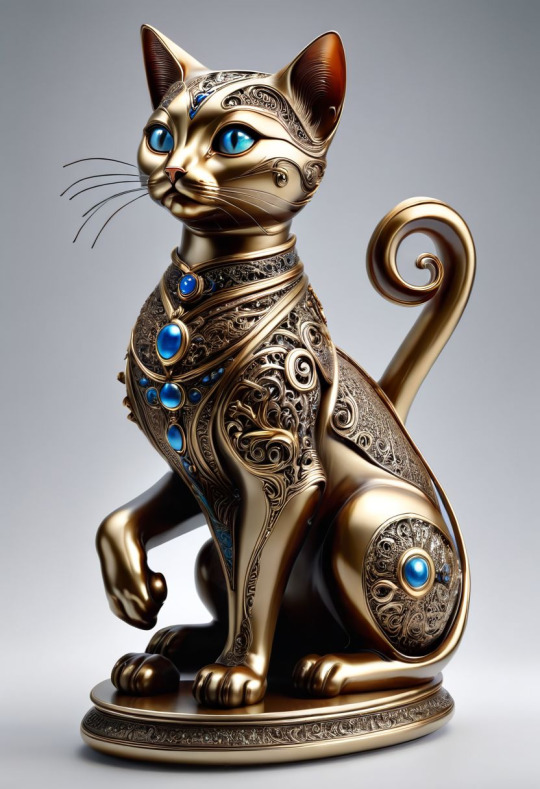
In a world not too dissimilar from our own, where the distinction between technology and magic had blurred into obscurity, the ancient metropolis of Avalora thrummed with a vibrant pulse. It was a city where historical artifacts wielded power beyond mere aesthetics, each resonating with the legacy of their creators. Among these revered relics was the Shellback, a mythical automaton shaped like a regal cat, crafted by the legendary artisan and technomancer known as Marvol.
Marvol, in his twilight years, had infused the Shellback with intricate circuits and spell runes that wove together gold and azure gems. This wasn't just a masterpiece of craftsmanship; it was a sentient being with eyes as deep and blue as the endless cybernetic void it monitored. The Shellback was designed for one purpose—to protect the Grand Archive, a digital repository that held the sum of human knowledge and the secret histories of countless civilizations.
One evening, under the cloak of darkness, a figure cloaked in holographic shadows approached the Grand Archive. Zara, a notorious data thief, known across the shadow networks for her ability to extract information where all others had failed, had her sights on the ultimate prize—the Codex Originum, a file rumored to contain the blueprints for original human DNA.
As she neared the entrance, the Shellback, ever watchful, detected the anomaly in its security matrix. Its eyes glowed a fierce sapphire, and the ornate carvings along its body shimmered with an arcane light. With the grace of a predator, it moved to intercept.
Zara, however, was no ordinary thief. Her gear, a mesh of ancient tech and new-age hacks, allowed her to converse with AI and manipulate their core directives. She stood before the majestic guardian, her device ready to deploy a symphony of digital whispers.
But the Shellback was not merely a creation of code and metal; it was an echo of Marvol himself, his wisdom and protective spirit embedded within. Instead of attacking, it communicated, its voice a rich melodic blend that resonated in the mind rather than the air. "Why do you seek the Codex?" it asked.
Zara, taken aback by the creature's sentience, replied, "To know where we truly come from. Isn’t it our right?"
The Shellback, understanding the weight of her quest, proposed a challenge. "Prove your worth through a test of creativity and innovation, as Marvol would have appreciated. Remix the ancient melody encoded within my core, a melody once composed by Marvol’s friend, Shellback the record producer, who transcended his era through music."
Using her sophisticated tools, Zara accessed the melody—a complex sequence of notes that seemed to blend every genre from the past millennium. She remixed it live, integrating elements of futuristic synthwave and ethereal glitches. The result was a harmony that told a story of human progress and aspiration.
The Shellback, impressed by her skill and moved by her respect for the art, stepped aside. "The Codex is yours," it declared, "for you have shown the true essence of what it means to be a custodian of knowledge."
Zara entered the Archive and downloaded the Codex, but instead of selling it as she had planned, she broadcast it across the net, granting everyone access to the origins of mankind. Her encounter with the Shellback had changed her, instilling a newfound reverence for the past and hope for the future.
Thus, the guardian of the Archive had not only protected its contents but had also guided another soul towards the betterment of humanity.
0 notes
Photo

This is an old drawing that I did that I just used some textures and put some colors on it I intend to create a "Creature Codex" working only on this style some day, let's see about that.
#animal#coruja#creature#owl#deviation of the day#dnd#dungeons and dragons#mixed media#nature#rpg#sketchbook#digital sketchbook#sketch#sketch of the day#365 days challenge#365 days of art#365 drawings#art of the day#art#creature codex
8 notes
·
View notes
Text
Shadowless Shadowdancer - CR8 Humanoid/Undead
This vampire has a shadow.
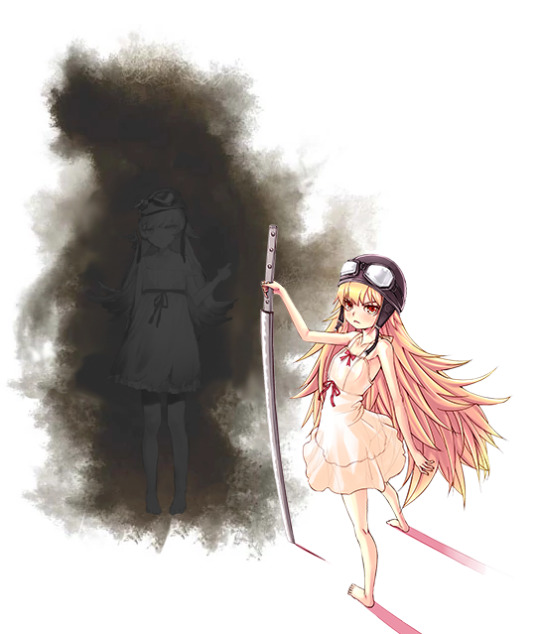
Artwork is a combination of art by Reason on Pixiv, art by lowercasek on DeviantArt, and art from D&D 3e by Wizards of the Coast.
Sorry for the double-multiclassed character with three archetypes and a template, but I had a very specific idea of what I wanted to do with this creature, and was determined to do so within the rules for once.
The artwork for this NPC is based on Shinobu Oshino, a vampire character from Monogatari, but the NPC’s powers really don’t have much to do with that character. I just wanted to make a shadowdancer. The NPC Codex and d20pfsrd don’t have a lot of NPCs with archetypes or prestige classes. And the idea of a vampire shadowdancer, who doesn’t have a shadow, but whose shadow disguises itself as her shadow, is just so cool. I ended up making the character a dhampir instead of a full-fledged vampire, though, not because of balance or flavor reasons, but just because it didn’t need any more special abilities.
NPCs don’t normally get traits, but she has a single drawback trait, so she gets a single beneficial trait to make up for it. The drawback trait causes her to have no shadow, like a vampire.
Outside of combat, her shadow stays in the ground as an incorporeal creature, but takes the shape of her shadow on the ground’s surface and matches her movements.
Shurikens have the monk special quality and can be used with flurry of blows, but her katana doesn’t. She can create a light monk weapon such as a siangham using Umbral Gear and make a flurry of blows with that, but there’s rarely a reason to do so instead of using shurikens or unarmed strikes. These attacks usually just do 1 nonlethal damage (which is what happens when an attack’s damage gets reduced to 0 by penalties), but most of her damage comes from sneak attacks and Prey On Fear. When performing a flurry of blows, she can spend a ki point to gain a fourth attack.
In combat, she often begins by charging an enemy to gain her sneak attack, using punishing kick to knock them backwards, and then activating her Quick Runner’s Shirt to back away. If an enemy moves up to her, she attacks them once and then uses Fast Getaway to escape. Once her Quick Runner’s Shirt is used up, she primarily attacks from range with flurries of shurikens. When escaping, she uses her Slippers of Scampering to run up the walls if possible. Her shadow companion acts as a front line tank while she runs around.
The shadow companion doesn’t give its own XP - it’s factored into the Shadowless Shadowdancer’s challenge rating and XP already, like an animal companion.
Shadowless Shadowdancer - CR 8
The girl seems like a normal human at first, neither armored nor carrying a single piece of equipment, and wearing only a sun dress - until she draws a weapon out of her own shadow. And then the shadow itself rises up from the ground, still bearing her image.
XP 3,200 Young dhampir, kishu + scout ninja 4 / hungry ghost unchained monk 1 / shadowdancer 4 CE Small humanoid (dhampir) Init +8 Senses darkvision 90 ft., low-light vision; Perception +21
DEFENSE
AC 27, touch 22, flat-footed 20 (+6 Dex, +1 dodge, +4 mage armor, +4 monk, +1 natural, +1 size) hp 46 (1d10+8d8) Fort +4, Ref +14, Will +6 (+2 vs. disease and mind-affecting) Defensive Abilities evasion, uncanny dodge
OFFENSE
Speed 30 ft. Melee +1 ghost touch effortless lace katana +16/+11 (1d6+7/18-20) or flurry of blows unarmed strike +13/+13/+8 (1d4-3) Ranged flurry of blows mwk shuriken +16/+16/+11 (-2) Special Attack flurry of blows, ki pool (3 points), punishing kick (3/day), scout’s charge, sneak attack +2d6
Spell-like Abilities (CL 4th; concentration +5) 2/day—silent image (DC 14) 1/day—shadow conjuration (DC 15), shadow duplicate (see text) 40 ft./day—shadow jump (see text)
STATISTICS
Str 4, Dex 22, Con 10, Int 8, Wis 18, Cha 13 Base Atk +7; CMB +3 (+13 with katana); CMD 27 Feats Dodge, Mobility, Punishing Kick, Slashing Grace (katana), Weapon Finesse, Weapon Focus (katana, shuriken) Traits Reactionary, Umbral Unmasking Skills Acrobatics +18, Bluff +6, Disable Device +20, Intimidate +15, Linguistics +3, Perception +21, Perform (dance) +6, Sense Motive +10, Sleight of Hand +10, Stealth +18, Use Magic Device +6 Language Common, Necril SQ stern gaze, umbral gear Gear +1 small katana, effortless lace (applied to katana), mwk small shuriken x50, amulet of natural armor +1, headband of inspired wisdom +2, quick runner’s shirt, slippers of scampering, wand of mage armor (23 charges; already used), wand of inflict light wounds (15 charges), concealed weapon sheath, concealed shuriken pouch
SPECIAL ABILITIES
Umbral Unmasking (Ex) The shadowless shadowdancer casts no shadow whatsoever. Typically, when not in combat, her shadow companion disguises itself as her shadow, hiding this fact. Creatures that succeed at a DC 15 Wisdom check in normal light notice the strangeness of her shadow (an additional Perception check may be required based on environmental conditions). This telltale sign of wickedness cannot be concealed by misdirection, nondetection, or illusions, except those that also affect shadows (such as invisibility).
Vampiric Empathy (Su) The shadowless shadowdancer can communicate with bats, rats, and wolves as if under the effects of a speak with animals spell. In addition, she gains a +2 racial bonus on Diplomacy checks when dealing with these animals. The animals begin with a starting attitude of indifferent.
Negative Energy Affinity (Ex) Though a living creature, the shadowless shadowdancer reacts to positive and negative energy as if she were undead—positive energy harms her, while negative energy heals her.
Resist Level Drain (Ex) The shadowless shadowdancer takes no penalties from energy drain effects, AKA negative levels, though she can still be killed if she accrues more negative levels then she has Hit Dice.
Unarmored AC Bonus (Ex) While unarmored and unencumbered, the shadowless shadowdancer gains a bonus to AC and CMD equal to her wisdom modifier. These bonuses to AC apply even against touch attacks or when she is flat-footed. She loses these bonuses when she is immobilized or helpless.
Hide in Plain Sight (Su) The shadowless shadowdancer can use the Stealth skill even while being observed. As long as she is within 10 feet of an area of dim light, she can hide herself from view in the open without anything to actually hide behind. She cannot, however, hide in her own shadow.
Flurry of Blows (Ex) The shadowless shadowdancer can make a flurry of blows as a full-attack action, giving her one additional attack at her highest base attack bonus. She must make these attacks using any combination of her unarmed strikes and weapons that have the monk special weapon quality (such as her shurikens, but not her katana).
Ki Pool (Su) The shadowless shadowdancer has a pool of 3 ki points per day. As long as she has at least 1 point in her ki pool, she treats any Acrobatics skill check made to jump as if she had a running start.
By spending 1 point from her ki pool as a swift action, she can do one of the following: Make one additional attack at her highest attack bonus when making a full attack Increase her speed by 20 feet for 1 round Give herself a +4 insight bonus on Stealth checks for 1 round
Prey On Fear (Su) Whenever a shadowless shadowdancer deals sneak attack damage to a shaken, frightened, or panicked opponent, she adds +4 precision damage to her first successful attack that she makes against that opponent each round.
Scout’s Charge (Ex) Whenever the shadowless shadowdancer makes a charge, her attack deals sneak attack damage as if the target were flat-footed. Foes with uncanny dodge are immune to this ability.
Shadow Duplicate (Sp) Once per day as an immediate action when the shadowless shadowdancer is hit, she can create a single shadow duplicate of herself, as per mirror image. The GM randomly determines whether the attack hit the shadowless shadowdancer or the shadow duplicate. The shadow duplicate lasts for 4 rounds or until dispelled or destroyed. This ability does not stack with the mirror image spell.
Umbral Gear (Su) As a standard action while in an area of dim light or darkness, the shadowless shadowdancer can coalesce wisps of shadow into a quasi-real, functional item. The shadowless shadowdancer must choose whether to make a crowbar, 50 feet of silk rope, a glass cutter, a light melee weapon with which she is proficient, a reversible cloak, thieves’ tools, or a wire saw.
The shadowless shadowdancer can use such items for 14 minutes per day. This duration does not need to be consecutive, but it must be used in 1-minute increments. An item created with this ability remains until the shadowless shadowdancer is no longer touching it, or until she runs out of duration for this talent, at which time it dissolves.
Punishing Kick (Ex) When attempting an melee attack, three times per day, the shadowless shadowdancer can attempt to perform a punishing kick. If the attack is successful, it deals damage normally and the shadowless shadowdancer can choose to push her target 5 feet or attempt to knock them prone. A DC 18 Fortitude save negates being knocked prone. The save DC is Wisdom-based.
Shadow Jump (Sp) The shadowless shadowdancer can travel between shadows as if by means of a dimension door spell. The limitation is that the magical transport must begin and end in an area with at least some dim light. The shadowless shadowdancer can jump up to a total of 40 feet each day in this way. This amount can be split among many jumps, but each one, no matter how small, counts as a 10-foot increment.
Shadowless Shadowdancer’s Shadow
CE Medium undead (incorporeal) Init +2 Senses darkvision 60 ft.; Perception +8
DEFENSE
AC 19, touch 15, flat-footed 16 (+2 deflection, +2 Dex, +1 dodge, +4 mage armor) hp 23 (3d8+6) Fort +6, Ref +10, Will +3 Defensive Abilities incorporeal, channel resistance +6 Immune undead traits, turn undead, command undead
OFFENSE
Speed fly 40 ft. (good) Melee incorporeal touch +9 (1d6 Strength damage) Special Attacks create spawn
STATISTICS
Str —, Dex 14, Con —, Int 6, Wis 12, Cha 15 Base Atk +7; CMB +9; CMD 22 Feats Dodge, Skill Focus (Perception) Skills Fly +11, Perception +8, Stealth +8 (+12 in dim light, +4 in bright light); Racial Modifiers +4 Stealth in dim light (–4 in bright light) Languages Common
SPECIAL ABILITIES
Strength Damage (Su) A shadow’s touch deals 1d6 points of Strength damage to a living creature. This is a negative energy effect. A creature dies if this Strength damage equals or exceeds its actual Strength score.
Inherited Abilities (Ex) A shadowless shadowdancer’s shadow has a number of hit points equal to half the shadowdancer’s total. The shadow companion uses the shadowdancer’s base attack bonus and base save bonuses.
Linked Death (Su) If a shadow companion is destroyed, or the shadowless shadowdancer chooses to dismiss it, the shadowless shadowdancer must attempt a DC 15 Fortitude save. If the saving throw fails, the shadowless shadowdancer gains one permanent negative level. A successful saving throw avoids this negative level. A destroyed or dismissed shadow companion cannot be replaced for 30 days.
5 notes
·
View notes
Link

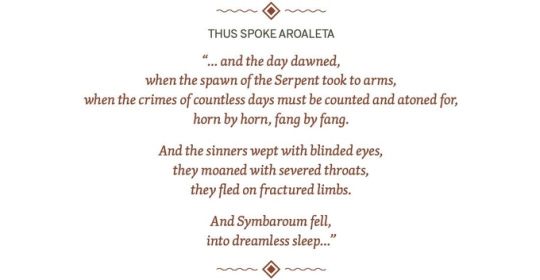
The acclaimed setting of Symbaroum has enticed and fascinated fans of tabletop roleplaying games since the launch of the game in 2016. Now this dark and mysterious world welcomes an even wider audience, with the production of a Player’s Guide, Gamemaster’s Guide and Bestiary adapted for 5E, published under the Open Gaming License. Note that you will need the core 5E rulebooks to fully enjoy Ruins of Symbaroum.
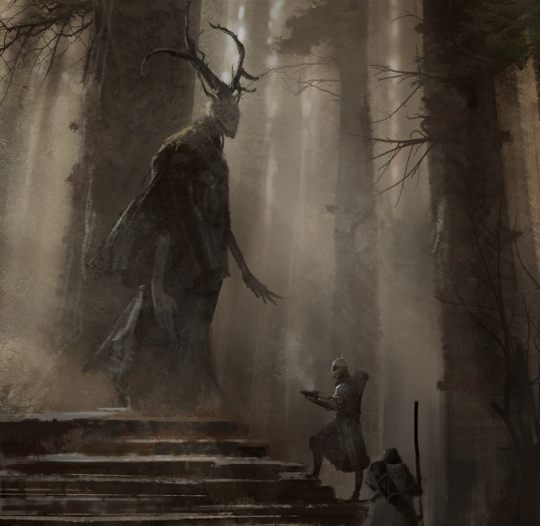
Welcome to the world of Symbaroum

The rich and nuanced Symbaroum setting revolves around the Ambrians – a civilization that two decades ago were forced to flee their ancestral soil after a devastating war. Their new and promised land borders on the vast forest of Davokar, covering the remnants of the Empire of Symbaroum which fell into ruin hundreds of years ago. Brimming with natural resources and mythical treasures, the forest calls out to the Ambrians to be explored and plundered, but the road into its depths lays far from open. Not only are the shadows beneath the foliage fraught with danger, monsters and infectious Corruption; there are also the elves of the Iron Pact who have vowed to die to keep anyone from disturbing the ruins of old, warning that the ancient evil of Symbaroum stirs in its sleep.

About ten years ago, Queen Korinthia of the Ambrians finally vanquished Chieftan Haloban and his Jezites.
Now you can join in the adventure! Seek out the barbarian clans to trade or to plunder their treasuries; establish a base of power among princes, guilds, or rebellious refugees in the capital city of Yndaros; survive encounters with trolls, dark-minded beasts, and undead warlords. But always remember the warnings spoken by the wardens of the forest: tread carefully and do not disturb the ruins of old, for the horrors of Davokar are about to awaken!
If you want a more in-depth introduction to the setting, with its dark wilderness, its warring factions and infectious corruption, you are welcome to download On the Nature of Davokar - a report from a lecture at the wine cellar Tuvinels in Yndaros, transcribed and commented by the famous explorer Iasogoi Brigo.


Aside from the base core rules referenced in the 5E OGL, the Ruins of Symbaroum Player’s Guide contains everything you need to create characters and set out to explore the world of Symbaroum. We provide this information in five major sections: an introduction to the setting, new rules for gameplay, new character origins, new character classes and feats, and a set of resources (equipment, spells, etcetera) for making characters and for use during play.
New Rules
To emphasize the dark fantasy nature of the setting, new rules for traveling and rests, social challenges, and magic are introduced. Regarding magic, wielders of mystical powers cannot avoid being affected by the ever-present threat of Corruption — the gathering of darkness to each character’s Shadow which, if left untended, can manifest as terrible physical transformations and even the eventual loss of the character entirely, as Corruption consumes them mentally and physically.
New Origins
Aside from familiar folks such as humans, elves, and dwarves, the Symbaroum game world lets you create PCs and NPCs who are changelings, ogres, goblins, trolls and even a particular form of undead. Also, the more recognizable folks differ quite radically from what you would expect – for instance, in Symbaroum the elves (rather than orcs, trolls, or similar) could be described as the default enemy of adventurers and explorers.
In Ruins of Symbaroum, character Backgrounds are generally tied to Origins. The following Origins and Backgrounds are included in the Player's Guide:
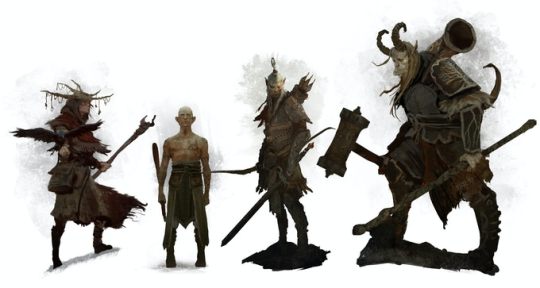
Origins: Human (clanfolk), Dwarf, Elf and Troll
Abducted Human - Runaway
Changeling – Broken Home, Mage’s Assistant
Dwarf – Dreams of Doom, Life-Debt, Outcast
Elf – Avenger, Exile, Mediator, Scout
Goblin – Laborer, Convert, Wild
Human – Common Folk, Faithful of Prios, Houses of Nobility, Merchant, Refugee, Scholar of Ordo Magica
Ogre – Learned in Magic, Raised by Common Folk, Sellsword
Troll – Artifact Collector, Journey of Discovery
Undead – Revenant
New Classes
The Ruins of Symbaroum Player’s Guide presents the classes Captain, Hunter, Mystic, Scoundrel and Warrior – each with between four and seven different approaches (called Subclasses in the 5E OGL rules), and all of them with customized features up to the 20th level. The captain class is something special, as its members have the capability to command and train others, to improve the fighting ability of a group as a whole.

Approaches: Ironsworn, Rune Smith, Weapon Master and Sorcerer
Captain – Merchant Master, Officer, Outlaw, Poet-warrior
Hunter – Bounty Hunter, Iron Sworn, Monster Hunter, Witch Hunter
Mystic – Artifact Crafter, Self-taught, Sorcerer, Theurg, Troll Singer, Witch, Wizard
Scoundrel – Explorer, Former Cultist, Guild Thief, Thug, Treasure Hunter
Warrior – Berserker, Duelist, Knight, Rune Smith, Tattooed Fighter, Weapon Master (plus unlocked: Templar, Wrathguard)

The graphic design of Ruins of Symbaroum borrows elements from the award-winning design of the original Symbaroum game.

Both these spreads are drafts (works-in-progress) from the Ruins of Symbaroum Player's Guide.

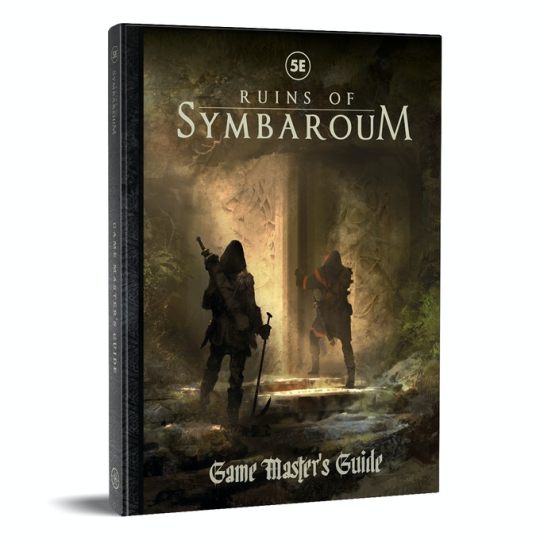
Note: the cover art is a placeholder and will be replaced.
The Ruins of Symbaroum Gamemaster’s Guide provides tools and guidelines for running the game, developing the setting and creating your own adventures. The content may be summarized as follows:
Invoking Symbaroum
Gamemaster’s Rules – on Ability Checks, Combat and Challenge Ratings, Time Within the Game, and Shadow and Corruption.
The Setting – describes three settlements central to the setting: Thistle Hold, the town of explorers and treasure hunters; Yndaros, the capital city of the kingdom of Ambria; and Karvosti, the cliff of the barbarian High Chieftain deep inside the forest of Davokar.
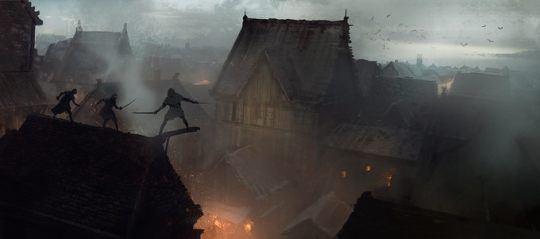
Running Ruins of Symbaroum
Building Game Worlds – guidelines on how to understand and develop the specific game world of Symbaroum.
Adventures and Landscapes – instructions on creating adventures and adventure landscapes where the PCs dictate the course and outcome of the story.
Chronicles – tips on how to design an adventure chronicle (also called campaign or adventure path) set in the world of Symbaroum.
Magical Items and Artifacts – a huge number of mystical artifacts that all come with ready-made adventure hooks, as well as guidelines on how to create mystical artifacts of your own.
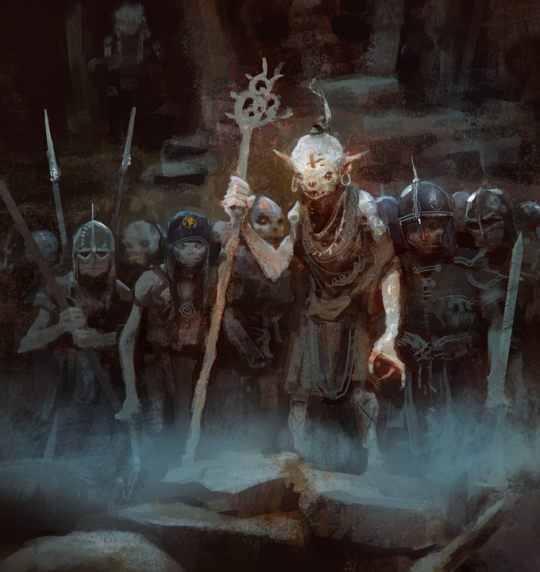
Optional Rules
Troupe Play in Symbaroum
Adventures in the Underworld, Yonderworld and Spirit World
Advanced Traps
Pitched Battles
PC-owned estates and domains
Forest expeditions of different types
Ceremonial Magic
And more


Note: the cover art is a placeholder and will be replaced.
The Ruins of Symbaroum Bestiary is in most respects a reflection of the award-winning Symbaroum Monster Codex, but with stats and rules adapted for 5E – the difference being that it also includes the monsters and adversaries featured in the Symbaroum Core Rulebook.
Hordes of the Eternal Night
Twenty-seven original creatures that haunt, roam and wreak havoc on the world of Symbaroum.
Each creature come with full color art, lore, an adventure Set-up and between one and four variants with different stat blocks
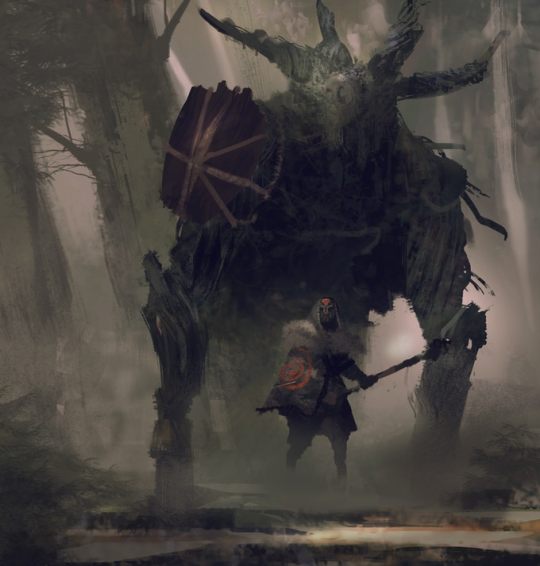
Beasts & Monsters
Approximately sixty creatures presented with shorter descriptions and stat blocks
Sorted into categories, such as Abominations, Predators, Spiders, Undead and Winged Creatures
Adversaries
Approximately seventy types of cultural beings presented with shorter descriptions and stat blocks
Sorted into categories, such as Champions of Prios, Elves, Outcasts, People of Davokar, Townsfolk and Trolls

The abominations of Davokar come in different shape and sizes...

Do you want to know more and even playtest some of the new mechanics right now? If so you should head over to DriveThruRPG and download the free PDF Ruins of Symbaroum 5E - The Promised Land.
There you will find some of the optional rules, a selection of origins, classes and approaches, along with four readymade player characters and an adventure. Enjoy!
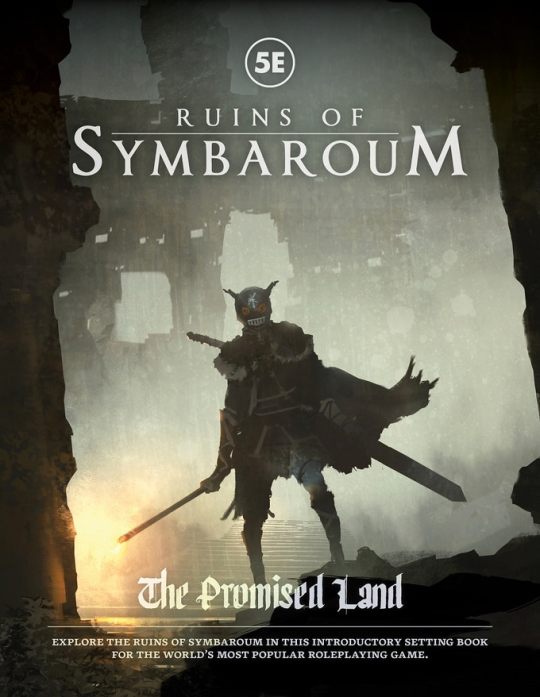
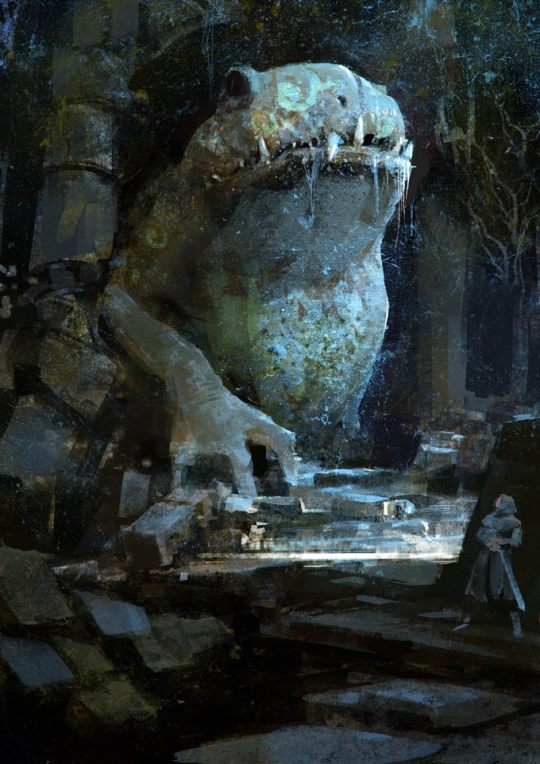
Kickstarter campaign ends: Thu, May 6 2021 8:00 PM BST
Website: [Free League Publishing] [facebook] [twitter] [instagram]
46 notes
·
View notes
Text
Perspective: Can redeeming Villanelle make her character less iconic?
Have you ever heard of the Codex Gigas? Also known as ‘The Devil’s bible’, it is the largest illuminated manuscript in the world according to Wikipedia. It is told that a monk made a pact with the Devil himself and feverishly wrote the entire book in one night! As an acknowledgment to his partner he drew his monstrous figure in one of the pages. Said page looks different from the others, as if touched by some malignant magic. Today we know the reason for it: the page suffered the most deterioration for being the most exposed. For centuries people could not get enough of this character: The Devil. Indeed, we have codified ways to save ourselves from the metaphorical Devil – ourselves. We invented sins and crimes to tame something deeply primal within us. Freud called it id, the origin of all that which makes us tick: impulses, instinct, drives, libido. It reckons only two things: pleasure and satisfaction. If we could strip ourselves from all inhibition there would be impulse and sensation. It would be brutal ecstasy. But what would be of the world if all 7 billion of us would uncompromisingly seek to satisfy our impulses? Hell, so we don’t.

But through art we can glimpse at what this liberation would feel like. Some sort of existential voyeurism. Aristotle would call it catharsis, but what does he know? This is how some of the most remarkable characters were born, they mesmerize us by being their id – unapologetically, terrifyingly, charmingly – like the Devil himself. Characters like Hannibal Lecter, The Joker, Alex DeLarge; they are larger than life, unbind, amoral and extremely bright (and all male). Like Hannibal brilliantly put it in Silence of the Lambs: “Nothing happened to me, officer Starling, I happened” or like the perverted childlike Alex explain in A Clockwork Orange: “What I do I do because I like to do”. As simple as that. Pure satisfaction of impulse because they feel like it. When we, uneased by what they represent, want explanations or justifications, The Joker toys with us, always giving us a different version of his tragic background, as if he knew we want to give him an excuse and, in good joker fashion, he makes a huge joke out of it. They take it very seriously to explain to us what went wrong with them, because it doesn’t really matter.

While the id makes us organic, whole creatures, many attributes of it have been culturally dissociated from womanhood. The violent, self-preserving and egoistic impulses were replaced with nurturing, self-sacrifice and compassion – not surprisingly the only impulse afforded to women is motherhood (or sexual desire for the satisfaction of another). Therefore, women cannot fully materialize their humanity. These raging impulses feel alien to womanhood, something imposed on to them by circumstance so severe that it warps the nature of the female itself. Aggressive women are sad and broken, or vengeful, or mad, or sexualized – these are the portrayals we have been conditioned to expect from fiction. When compared to their male counterparts, even mild violence in a female character almost immediately requires an explanation: how someone betrayed them, or abused them, or they were conditioned into it. Rage and aggression are never theirs to own, it is always extrinsically sourced.
On a superficial level, the character of Villanelle doesn’t seem so unique. Immediately one could think of Nikita in La femme Nikita, who was a drug junkie teen, rescued and transformed into a cold-blooded femme-fatale assassin by the shadowy government group “The Centre” after they faked her death to break her from prison (Uncannily similar?). Or the movie Anna by the same writer, where a Russian girl accepts a KGB offer to be trained into an assassin in order to escape her abusive homelife. Or Marvel’s black widow who is also a Russian spy, apparently brainwashed by USSR to become an assassin. Other female assassins include The bride in Kill Bill who set off into a revenge killing spree after being brutally assaulted and left for dead, and other movies I vaguely remember about abused women becoming assassins to seek revenge, or shallow sexy female assassins with no purpose for existing other than being the sexy female assassin. However, all these characters were made into assassins by external factors. Villanelle is set apart from the typical femme-fatale assassin trope by owning her own joy of killing, by the rejection of the broken female narrative and the rejection of the objectifying male gaze. In order to unmistakably ground these traits alienated from women – violence, disregard, cruelty, indifference, sadism, risk-taking – in her nature, the character was written as a primary psychopath. Being an assassin fits her natural talents, not the other way around

Villanelle could occupy a very special place among a roster of remarkable fictional characters like the ones mentioned earlier. She is the female embodiment of absolute, remorseless indulgence and rage, representing the unashamed satisfaction of women’s impulses, for her own enjoyment alone, with style and wit – A truly magnetic character and fresh perspective. In psychopathic Villanelle, women are allowed to reclaim these violent impulses, which is oddly empowering and humanizing. Give us that. Brilliantly, the cathartic element is mirrored by Eve herself. Eve too sees her unfulfilled and alienated impulses incarnated in Villanelle, which in turn sparks Eve’s exploration of her own identity. Ultimately Villanelle’s seduction to embrace impulse despite its danger is at the core of their electric attraction and conflict.
Thus, by retconning Villanelle in Season 3, the character no longer represents the provoking embodiment of female drive, managing to become an elevated female assassin trope, at best. The challenging take on womanhood, instead plays into all of the expectations. Villanelle is no longer a female true to her nature that gets a kick from being an assassin; but a troubled girl, tortured into becoming a killing machine by a past of abuse. A broken woman who rejects the violence instilled into her once she finds healing. Interestingly, it is not that she merely chooses not to kill but she is unable to carry on the act, signifying the deeper alienation of the violent impulse from her own self – the same impulse that once made her so iconic. This lack of impetus to kill is but a symptom of the decreased character’s libido in general: fewer shopping sprees, less savory eating, less unpretentious playfulness, less color, less eroticism, less aggression, less danger. Unfortunately, it also means the weakening of her dynamic with Eve. Villanelle is being tamed, and its well… not her best take.

We, the audience, perceive this lack of vitality oozing into the entire show, but once you shift what Villanelle represents this is inevitable. Villanelle becomes mundane, and it brings the nostalgia of the force of nature she once was. It leaves a similar taste as the brutal transformation of Alex from despicable nihilistic hedonist into a model citizen in A clockwork orange: a conflicted perverted sadness at the loss of Alex’s authenticity despite him turning into a “better” human being – ingeniously, his redemption was to gain his despicable impulses back.
The initial character design of Villanelle was something unique and authentic. However, In the process of redeeming her, she might become a new iteration of a trope explored several times that simply reflect the current space of female characters and lack conceptual originality. Yet, there is still room for the recuperation of Villanelle’s transgressive power: a subversive redemption. By incorporating the impulsive indulgence and violence back into the character, Villanelle’s arc can be taken somewhere new, complex and truly special. A remarkable character we can’t get enough of – like the Devil herself.

#killingeveperspectives#killing eve#killingeve#killing eve retcon#killing eve analysis#killing eve review#villanelle#villanelle analysis
41 notes
·
View notes
Text
Warhammer Paper
I wrote this for a history class on Warhammer Fantasy, some people have asked me for it so here you go
Neither Holy nor Roman nor an Empire: Warhammer Fantasy’s Imagination of the Empire
A note on terminology. Warhammer is the larger brand that all of the following games fall under, with a specific aesthetic, culture, and identity in the larger fantasy space. The property is divided into two types of games, and two “settings”. Warhammer Battle, a wargame, which players take armies of miniatures. Warhammer Roleplay, is a table-top roleplaying game ala Dungeons and Dragons set in the Warhammer world. These games are split between two settings, an imagined world where the action of the games are supposed to take place, so the battles between the Ogre and Daemon armies are given a context within the world of the fantasy. The settings include the original Warhammer Fantasy, and it's far more popular science fiction equivalent Warhammer 40000 (usually known as 40k). This work will look primarily at Warhammer Fantasy and not 40K, specifically its depiction of the Holy ROman Empire in its fantastical equivalent, the Empire of Man. Warhammer Fantasy draws heavily upon early modern history for inspiration, down to its own world map.
The world of Warhammer Fantasy, in contrast to works like as Lord of the Rings, draws primarily upon historical influences to populate its world. The Kingdom of Bretonnia is obviously inspired by France, the Empire of Cathay and Nippon aren’t even hiding that they are based on China and Japan. And the core part of the setting where most of the action is set, is the Empire of Man, inspired by the Holy Roman Empire, with its Emperor elected by a series of Elector-Counts ruling over a deepy decentralized state. While Warhammer Fantasy is a somewhat comedic game, it is worth studying how it depicts the Holy Roman Empire, because that is how much of its Anglophile audience is going to first learn about its real life equivalent.
The subject of this paper is Warhammer Fantasy (WF), the series that started the Warhammer franchise. This setting encompasses both the games of Warhammer Fantasy Roleplay (WFR) and Warhammer Fantasy Battle (WFB), and I will be using the books from those games interchangeably because, while they are different games, the setting and the lore is the same,. Warhammer Fantasy is set in “The Old World”, a fantasy world under constant threat by supernatural forces. While the world is populated by a variety of fantasy creatures like Ogres, Dwarves and Elves under threats of “Daemons”, the main focus of the world are the human kingdoms, roughly modelled after real life historical societies. While the entire world is loosely sketched out, most of the action of the game is set in “The Empire of Man”, located in the middle of a fantastic version of early modern Europe.
The franchise of Warhammer is wargaming, where player enact battles with an army of miniatures on a board. These miniatures must be purchased from Games Workshop and prices can run as high as over $100 dollars for a monster miniature, meaning the game is limited to an affluent fanbase. Players don’t simply buy the minaturse, they also paint them, the miniatures when purchased as black and white pewter figurines which the player paints with brushes and paints also provided by Games Workshop. The games website has recommended colors for each type of figure but players may customize their mainatures as they choose, giving players a personal connection to their own collection. While players may purchase as many miniature as they wish, officially each set of minaturse is organized into different “armies”. Each army has a theme and unique design, and units from a particular army is only supposed to work within its own army. So for example, the High Elf Army are the only units who employ High Elf Mages. The Knights of Bretonnia cannot be used in the armies of the Empire. These armies each have a unique play style and most players can only afford to play with a few armies, generally leading to players committing to a single army they identify with. In addition to buying miniatures and paints, players must also buy the rules for play. In addition to the general rule book must be bought by all the players, each specific army also has a special rule book known as a codex. The codex does not only contain the specific rules for each army but also the story line, character descriptions and society of each faction. For example the empire codex contains not only the specific rules for each unit but also the personalities of the individual important figures, the history and culture of the empire and the character of the empire as as a whole, complete with pictures.
In game design terminology, the is the divide between what is called mechanics and story (or fluff). Mechanics covers the actual game play such as how much damage each each unit deals and what special attacks they have, while the story covers the specific character of each unit. Warhammer Fantasy was started in 1983 and has gone through 8 editions until the game eventually ended in 2010. The first two editions were actually nothing but armies with no story with them at all beyond a few sentence, it wasn’t until third edition came about in 1987 that the actual setting was created and the Empire of Man existed as anything more than “The human faction”. And from every edition since third, new codex have come with update the story, introduce new factions, or change the state of the world.
The variant game Warhammer Fantasy Roleplay ues entirely different mechanics but the same story. The experience of a tabletop game, modelled off Dungeons and Dragons, a form of interactive storytelling, consisting of several players sitting around a table. One player is called the Game Master (GM) who creates the story and maintains the rules. Each of the other players creates a single character who they control. Each character has a set of powers and the characters can take actions which are determined by dice rolls. So if one players wants theri character to attack a goblin, they roll dice to see if he is successful. The characters work together to try to overcome the challenges the GM throws at them. Rather than vast battles, the mechanics of roleplay tends to have a greater emphasis on character interaction, the day to day living of the characters, and small scale combat. So mechanics exist not only for combat but also for socializing, stealth, and crafting objects, and these rules are laid out in large hard copies called Gamebooks. For the game to be played one person in the groups must have the Core Rulebook, but supplementary rulebooks exist covering other aspects of the world and the game. Each rule book contains both mechanics and story, however the story in these games is far more in depth and detailed than the Wargaming counterpart. For example, the primary source for this paper is Heirs of Sigmar, a supplement book designed to flesh out the culture and history of Empire. It contains some specific rules, but the vast majority of the book is simply story, which does not contradict the story of the Wargame. Thus both games share the same story even as their mechanics are entirely different. The fact that two games with entirely different mechanics can have the same story shows that the mechanics don’t contribute to the story, which is known in ludology as “Ludonarrative dissonance”.
Ludonarrative means ‘play narrative’ and refers to when a game’s narrative is expressed via its play. To use an example from video games, in acclaimed horror game Silent Hill 2, the ending of the game changes depending on how the player acts in game. Should the player use reckless tactics, rarely heal, and avoid stealth options, then the protagonist, James Sunderland, will commit suicide at the end of the game. If the player is cautions and explores the area, they will leave the town to make a new life. Ludonarrative dissonance is when the narrative of the play is in direct contrast to the narrative of the story itself. In both games, the mechanics of Warhammer fantasy are largely disconnected from its themes and story. All this to say, this essay will not be looking at the actual gameplay or mechanics, which have very little to do with its understanding of the empire. The focus of this essay will be solely on the story content provided in the game books, thus little engagement will be made with ludology of the game, which could be the subject for a future paper. As this franchise has been around since 1987, I will be drawing primarily upon the WFR book Heirs of Sigmar a guide to the Empire, and the 6th, 7th, and 8th Empire codexes, which go into the most detail about story rather than rules.
The Empire is 2532 years old when the book is set, and its history is told through a series of epochs. Humanity lives as primitive tribesmen until they discover the gift of iron, which leads to a time of barbarism and war. This ends only when a great warrior, Sigmar, unifies them though faith in his wolf god,and force of arms. Sigmar ruled wisely and justly, setting up most of the institutions of the later empire, and upon his retirement, the 12 great Counts instituted the Elector system. For a thousand years the empire goes through a prosperous golden age, expanding across the continent and becoming the greatest military force in human history, referred too as “The Birth of Nations”. This time of wonder ends with the age of decadence, as the upper classes gave up their concerns for the state to enjoy affairs, fine foods, and frivolous spending (much of it on art and fashion). Emperor Ludgiw II Honenbach “The Fat” makes his halfling cook an Elector, and the cult of Sigmar into the official state religion of the empire before “died in bad a short while later-smothered to death by his own neck fat”. This period of luxury eventually ends with a great plague, and civil war, Boris Hohenbach “the Incompetent”, is so corrupt he effectively cedes all control to the feudal lords rather than the Empire. It is the decentralization of the empire that marks its decline, known as the “Time of Judgement”. It wasn’t until the election of the martial Emperor Mandred I, whose reign brought stability if not prosperity to the realm, and his even more marshal successor Magnus who unified the Empire through “sheer force of will and belief” that this time of instability came to an end..
The games presentation of history is standard for the fantasy genre, and is both simplistic and rather conservative. Every event in the Empire’s history has a single cause, whole centuries can be summed up with rough generalization, and history is moved by individual men. And it is always men, during the first 1750 years of history only 3 women are mentioned, a nameless priestess to the goddess of diplomacy, a frivolous vain noblewoman, and a failed usurper, each with half a sentence of description. The lack of female representation is a consistent pattern across the Warhammer franchise. The good rulers are universally military commanders whose reigns last decades, as prosperous as they are vague. The Empire has an astronomical time frame but largely does not change except in the way of technology, it is always Germanic, decentralized, highly militant, and worshiping the same gods. The Empire is largely timeless, only changing when an in-game event requires it.
The effect is a state that is largely timeless, an eternal stereotype that simply exists with only slight variations, a deterministic view of society that fits many fantasy settings. Fantasy tends to imagine the past as one of stasis, the states that exist have done so for a long time and will continue to do so unless something truly cataclysmic occurs. Within that existence, they will stay largely the same across there history, if changes occur it will be due to a specific ruler or a major event. Fantasy imagines time as a stalled machine, awaiting a radical push to make it move slightly ahead before stalling out. If fantasy serves as one introduction to historical societies, it can give the impression that the Empire was a static entity, existing for centuries largely unchanged. This can very easily move into essentialism, one can simply dismiss the empire as a thousand years of stagnation and its people effectively the same. We see this essentialist approach later when the book describes the specific provinces, all of which have been largely the same for 2500 years, as having a specific character that defines them, even at some point implying it is due to bloodline.
At their worst, Nordlanders are churlish, uncouth, and thoughtless speakers. Even the merchants of Nordland have this blunt approach, though they seem to be fine with double dealing. Indeed, they have found that shouting the final price of something loudly and repeatedly has a profound effect upon merchants used to the subtleties of barter and negotiation. Many provinces point out that this is because of their mongrel Was Jutone, Teutogen, and Norscan bloodlines. This mixed heritage has been a source of Nordlander shame. Modern Imperials look on Norscans with a mixture of admiration and fear, seeing them both as powerful warriors and wild, uncivilised barbarians, not to be trusted around one’s daughters or sheep. A popular Imperial saying runs “Character is in the blood,” meaning that ancestry determines character. Thus Nordlanders, though of the Empire, are often regarded as “not quite one of us,” rougher and more uncouth even than the wild and hairy Middenlanders.
It effectively buys into primordialist narratives of human society, that when human beings first emerged they have characteristics that stay with them across all of time, like French Nationalist narratives claiming the Gauls and modern French share similar values and disposition. This is a common trope in fantasy, but by tying it to a real life historical entity, it gives the impression that this has some relation to German history.
As to what the Empire’s essential qualities are, Warhammer seems to been written with Voltaire’s misunderstood condemnation in mind. The Empire is deeply incompetent, disorganized, corrupt, and maddingly complicated. As Warhammer Fantasy was originally a comedy game, the section on the political structure of the empire was originally presented as a joke at the expense of the Empire.
But while the rhetoric around the empire is mocking contempt for its decentralization and overlapping spheres of influence, the Empire of Man in fact is not that complicated. While it is a decentralized feudal state with an elected monarch, and overlapping legal systems, it is actually less complicated than the real Holy Roman Empire. The Vatican is located within the Empire, the royal family has no international element to it, there is no equivalent to the Spanish Habsburgs or the American Colonies, no crownlands or Greater Hungary, and of course the empire has one language. In fact, the Holy Empire seems far more like a unified Nation-State than its real life counterpart.. One of the most notable changes made is that it doesn’t have an equivalent to the Hapsburgs, the Emperor is simply elected from among the Electors rather than from an Imperial family, and so one of the greatest elements of internationality has been removed. The fact that the empire is so much more cohesive and yet is mocked by its creators for its instability indicates just how much the ide of the nation-state has become normalized that a state not being utterly centralized is seen as strange.
Where this simplification and disinterest in the empire gets interesting is its approach to nationality or rather lack of one, as the Holy Empire is entirely German. The word German never appears in the books of course (though the term Teutonic certainly does) but the culture of the Empire is clearly German, the Emperor is named Karl Franz, its greatest warrior is named Lugwig Schwarzhelm, and the Reiksmarshal is named Kurt Helborg. The capital city is Altdorf (Vienna), and one of its famed military units are known as the Landsknecht. However the empire has no stand in for Hungary, Bohemia, Slovenian, Slovakia, or Poland, the culture is almost entirely German. The only exception is the semi-independent province of Sylvania, which is loosely based on Romania, though its depiction owes more to Bram Stoker than historical reality, ruled as it is by the vampire counts, and clearly based on Transylvania but with a Romanian cultural influence.
This Germanization shouldn’t be surprising considering that Games Workshop is a British company whose audience is overwhelmingly American and Canadian. None of the major designers are historians or have any expertise in the region nor do any of them mention any central European heritage. The Anglo-American world and the fantasy genre is not particularly well informed about Eastern/Central Europe, to the point that The Witcher, a Polish inspired fantasy game was released, it was praised for bringing attention to an unappreciated region. Germany is far more familiar, as is Romania thanks to Dracula, but as there are no major fantasy works featuring any of the other components of the Holy Roman Empire. Thus the Empire becomes a Germanic one, simply decentralized, with no Slavic, Magyar or Ottoman cultural influences to be found within its defined borders. This general ignorance of the region also explains the rather reductive embrace of Western dismissals of the Holy Roman Empire. In fact compared to most fantasy narratives, Warhammer is almost orientalist in its approach to German culture, the book presents German culture as exotic and strange, an the art work empathises the Gothic architecture and black armor much like similar fantasy exoticizes fantastical depictions of Japan.
Ironically, this ignorance of the region means that the Empire avoids many of most common troubled narratives of the empire, by reimagining the Empire as fully German, it reject a Nationalist critique of the Empire. For all its faults, the Empire isn’t oppressing ethnic groups yearning to be free, nor do any of its weaknesses come from diversity or lack of linguistic unity. Though the Empire slogan is “Let Us Take Strength From our Diversity” In a similar vein, Warhammer also unintentionally rejects the Clash of Civilization narrative, by the lack of an Ottoman presence. While there is a fantasy Islamic empire (The Araby Caliphate) it is both Arabic and largely irrelevant to the events of the main story. While the Empire does claim legitimacy by being the protectors of the true faith and the defenders of civilization, it’s rival are inhuman Daemons rather an exoticized oriental potentate. In fact while the empire considers itself the supreme cultural power, they do not seem particularly hostile towards any of their humans neighbours, nor do they have an enmity towards the Islamic inspired nations.
In fact the Empire’s relationship to religion is complicated. Like most fantasy works, the state religion has the aesthetic, organization, and place in society as the Catholic Church, with grand cathedrals and hierarchy of priests, complete with its own Pope, the Grand Theogonist. However the actual faith is polytheistic, with a pantheon of deities each of whom governs an aspect of reality. Its chief god used to be the wolf god Ulric, whose chosen Sigmar founded the empire, but the Cult of Sigmar has since become the state sect of the Empire. These gods exist in opposition to the Chaos Gods, whose Daemonic armies serve as the primary antagonists of the setting. Each god has its own organized church, but all of them are ultimately lead by the Cult of Sigmar, whose main job seems to be the maintenance of the inquisition. In Warhammer, the Inquisition, employs Witch Hunters and Templars in order to hunt down renegade spell casters and worshipers of Chaos, who purged via fire. In the world of Warhammer, the world is under attack by the forces of Chaos, divine cosmic forces of destruction and corruption. While they openly invade the empire from the north with their great Daemon armies, within the empire the lords of Chaos attempt to spread their influence through Chaos Cults. Individuals join for magical power and pledge their souls to Daemon overlords, eventually twisting their minds and body into combinations, and are instructed to try to overthrow the empire. The main obstacle to these cults are the inquisition, who can hunt down these secretive groups and destroy them through fire. The game evokes the imagery of the inquisition and witch hunts, but in this fantastical setting, the actions of the church are largely justified as chaos cults are legitimately threaten the world. In the universe of Warhammer, torture, mass execution and the constant repression of the citizenry is shown to be a justified necessary evil to prevent the empire from falling to chaos. Since Chaos often spreads through the reading of forbidden tombs and hedonistic ‘pleasure cults”, sexual puritanism and limiting freedom of information are shown to be entirely justified. Effectively Warhammer has created a world where the Inquisition isn’t not just necessarily but just in its actions, while doing most of the same activities as its real life counterpart.
This approach towards religion is common in fantasy, likely do to wanting to mix the excitement of Greek mythology with the familiar structures of Catholicism, or simply because the norms of Christianity are so normal to the writers that they struggle to imagine religion differently. For example, in Dungeons and Dragons, the pantheon of gods who exist within the world are clearly polytheistic in nature, however each god has a very Catholic inspired temple with an organized church hierarchy, using the imagery of christianity in a non Christian context. With the Inquisition hunting down and destroying hidden heretics within the empire, the game’s trappings are mimicking that of the Protestant reformation, but the role of Protestants is being played by Chaos Cultists, and the Inquisition is actually hunting witches. This means that the Empire losses much of its ideological nuances, one is left with the impression that faith in the empire is mostly a practical tool to battle Chaos, and the church is universally made up of corrupt hypocrites or zealous fanatics.
The game makes a point of mocking the Holy Roman Empire for its needless complexity, but the society is reduced on every level, which makes it easier to simply dismiss. This approach extends to almost all other aspects of the Empire, almost everything within it is defined in extremely broad strokes without much attention to detail. The Empire has a strict class system, with an aristocracy characterized as decadent, selfish, and vain ruling over a mass of peasants who are shown as ignorant, superstitious and xenophobic. The history is vast but sparse on details, and tends to fall into patterns, as periods of decline are ended when a warrior emperor drives back an external invader. This approach to world building is rather typical of most fantasy, as it generally hopes to work within broad archetypes rather than specific narratives.
All this is only worth considering because the larger Warhammer franchise has come under much discussion regarding nationalist themes in its work, though mostly focusing on its far more popular 40k franchise. The series enduring popularity with White Natioanlist and Trump supporters has been well documented, Trump’s official reddit page /thedonald regularly refers to “God Emperor Trump” a reference to 40k universe. The 40k universe has been accused its embrace of militarism, authoritarianism and xenophobic narratives, expressed through its protagonists being the dictatorial human supremacist “Imperium of Man”. Very little has been written about the original Warhammer Fantasy due to its relatively unpopularity compared to its spinoff, but it is worth considering from a nationalist narrative. The Empire of Man’s embrace of German culture and folklore is telling, in particular a blond warrior unifying the forest tribes to create an Empire via war. All of the good emperors are marshall, and the bad are defined as decedent and corrupt, with women confined to marginal roles. The Inquisition is shown as a necessary evil and the empire has a primordialism attitude towards the tribes that make up its ranks. A nationalist reading isn’t necessarily intentional, but it is possible, though not the traditional narratives associated with Central Europe. Rather it is more likely some of the long standing conservative sentiments that have long been associated with the fantasy genre.
First released in 1983, Warhammer is among the oldest and most popular fantasy properties in the gaming space, and it is one of the few fantasy franchises which plays a major part in changing the pop mersculture landscape rather than being fully insulated within the fantasy sub-culture. Warhammer 40K is the most popular wargame in history and the label has more than 50 video game spinoffs, Warcraft famously was originally planned to be Warhammer game before they lost the license and made their own universe. In fact most fantasy wargames owe their legacy in some way to Warhammer, which can be found in hobby shops across Europe and North America, though Games Workshop does not own the shops directly. It is almost impossible to be within fantasy gamer culture without at least passible familiarity with the Warhammer franchise, and so to many people, Warhammer Fantasy is their first real introduction to the Holy Roman Empire, albeit in a bastardized fantasy form.
In his influential 1936 essay, Beowulf: The Monsters and and the Critics, J.R.R. Tolkien lays out his understanding of the fantasy genre. At the time, Beowulf was valued primarily as a historical work and not a literary, a trend Tolkien argued against, making the argument that fantasy should be appreciated as stories within their own context rather than simply reflections of our reality. This approach is empathised in Lord of the Rings, where the emotional stakes within the confines of the fantasy universe. The reader hopes Frodo will succeed not because he represents something external to the story, but because we value the character and want what is best for him. Tolkien, in his prelude to Fellowship of the Ring, famously said he despised allegory and didn’t wish his work to be read with real life parallels. Most fantasy follows in Tolkien’s footsteps, Fantasy has long expected stories to be understood within their own context but that standard becomes confusing when real life elements are consciousnessly moved into the fantastical space. So when Warhammer Fantasy features a society obviously inspired by the Holy Roman Empire, the audience is expected to engage with the empire within the framework of its world, our investment in its success depending on our investment with its characters and setting. However we can’t ignore the fact that it is obviously inspired by a real life society, and that the game is unintentionally setting the groundwork for its players engagement with the historiography surrounding the empire. And so, while it is clear that the designers didn’t have any intention to make a statement about the historiography, instead using the Empire to give their game a unique aesthetic and stand apart from other fantasy properties, Warhammer does unintentionally make a statement about history. The stereotypes of the empire as incompetent and needlessly complicated, the view of history as largely static, that history is to be understood as mostly driven by great men, and that the decline of empires is inexorably tied to its embrace of luxury. The game enforces the notion of the Nation-State as normal and the Empire as abnormal for departing from said model. The game presents many institutions of the empire without contextualizing them, and doesn’t acknowledge the actual complexities of the real empire. Ultimately while this is the only prominent fantasy work which asks the players to imagine things from the Empire’s perspective, it very much enforces many of the same stereotypes that Habsburg historians have been trying to escape from, while also endorsing many false views of history itself. The games understanding of history is just close enough to reality that the uninformed player might take it as fact, without realizing just how essentialist Warhammer fantasy actually is. Much more attention needs to be paid to how history is understood via fantasy, because many people get their knowledge and interest in history from fantasy, and many concepts long since debunked in history, continue to live on in fantasy uninterrupted.
Sources
Ragan, Anthony, Warhammer Fantasy Roleplay, Heirs of Sigmar: A Guide to the Empire, Fantasy Flight Games, Green Ronin Publishing, 2005
Pramas, Chris, Warhammer Fantasy Core Rulebook, A Grim World of Perilous Adventure, Fantasy Flight Games, Green Ronin Publishing, 2005
Schwalb, Robert J, Warhammer Fantasy Roleplay, Tome of Salvation: Priests of the Old World, Fantasy Flight Gaming, Green Ronin Publishing, 2007
Straufer, Marijan von, Warhammer Fantasy Roleplay, Realms of Sorcery, black Industries, Fantasy Flight Games, Black Industries Publishing, 2005
Schwalb, Robert J, Warhammer Fantasy Roleplay, Tome of Corruption: Secrets from the Realm of Chaos, Fantasy Flight Games, Black Industries Publishing 2006
Chart, David, Warhammer Fantasy Roleplay, Knights of the Grail: A guide to Bretonnia, Fantasy Flight Games, Black Industries, Green Ronin Publishing, 2006
Cruddace, Robin, Warhammer Armies: The Empire (8th Edition), Games Workshop Publishing, 2010
McNeill, Graham, Warhammer Armies: The Empire (7th Edition), Games Workshop Publishing, 2007
Cavatore, Alessio, Warhammer Armies: The Empire (6th Edition), Games worship Publishing, 2000
Tolkien, J.R.R, Beowulf: The Monsters and the Critics, London: George Allen and Unwin, 1936
Tolkien, J.R.R., Lord of the Rings: The Fellowship of the Ring, Del Rey, Reissue edition, 1986
5 notes
·
View notes
Text
The Voice of Ghilan’nain: Introduction to my Blog
My beloved subjects: This is my first post on this blog so I will take a moment to introduce myself. My name is Gerasimos (though Jerry is what I usually introduce myself as out of courtesy, as both my name and surname sound like gibberish to most people). I’m a 23-year-old male biology student currently studying in Greece, and an aspiring entrepreneur with quite a long way ahead until I make that dream come true.
Before I introduce you to this blog, I would like to say a few more words about myself. I am a firm believer in education (scientific, technological, and financial) and I do enjoy learning new things, especially if they can be used to solve problems. I am interested in astronomy, biology with emphasis on plant biology, game design, and video game art. I also enjoy walking outdoors, cooking, relaxing at a beach while stargazing, talking about politics and money, teasing the cat (my friend, not the feline pet) and playing video games.
In regards to the latest subject, Bioware’s Mass Effect was the first RPG game I ever played. Though it took me a year to appreciate it due to its lackluster gameplay and limited weapon options, I eventually managed to see it for what it was rather than what I wanted it to be. I played through the trilogy with a dictionary next to me as my English skills were laughable back then. It was through Mass Effect and later Halo that I built my English skills, with the later giving me the opportunity to be part of a great community filled with incredible members such as Haruspis, Covenant Canon, HiddenXperia, LateNightGaming, and Halo Canon. I also had my ride as part of the Halo Archive community, with wonderful discussions and theories throughout the years, and I was fortunate enough to watch the community grow from 40 to over 2000 members and survive several crises until its eventual collapse. During the three or so years that I was part of the Halo Archive (known there as Faber of Will and Might), I got to see video games as far more than just games and develop a passion for delving deep into the lore of video game franchises and their extended media. It is for this reason, that I would like to take a moment and thank every member of the Halo Archive for the incredible conversations and debates we had during that time and particularly Haruspis, whose incredible analyses partially inspired me to start this endeavour (You can visit his blog by clicking here: https://haruspis.blog).
It was during the end of my first year at University that I got into tabletop gaming, but it took several years for me to discover the existence of Dragon Age. Eventually, both the release of disappointing games, like Halo 5: Guardians and Mass Effect Andromeda, and toxic fans caused my interest in these franchises to wane and the Halo Archive to fade. This caused me to search for new franchisees to fall in love with and this is how I got into the world of Dragon Age, starting with Inquisition. THE Dragon Age Setting is currently my favourite fantasy setting and the reason I started making “my own” tabletop RPG for it in order to play Inquisition with my friends. I used the quotation marks in the previous sentence because I started by homebrewing for the Official Tabletop DA RPG with each update and homebrew rule making it more and more distinct from the RPG it derived from and pushing it closer to the feel of the games, with mechanics like Barrier, Guard, Status Effects, Critical Hits, the addition of several dozen warrior, rogue and mage abilities and spells, the removal of the stunt mechanic, the introduction of sustained abilities and many more features.
I have always found Medieval English themed settings and happy worlds boring and dull. I don’t see fiction as escapism from problems but as an opportunity to do things I would normally be unable to do, such as setting foot on alien worlds, standing against the Covenant as they kill billions in their genocidal campaign or simply playing as an elf that throws fireballs at sleeping targets in the midsts of a death cloud and then paralyzing them or scaring them to death by casting Horror. Due to my bias against the classic medieval fantasy setting, Ferelden is the least interesting part of the Dragon Age setting for me. I do enjoy the extravagant gold and blue themes of Orlais, the Necropolis of Nevarra, the villainous city of Kirkwall, the Blighted Anderfels, the decadent Rome/Byzantium inspired Tevinter cities, the war-torn Seheron, the pirate heaven of Estwatch, the exotic Rivain and Par Vollen, the assassin filled Antiva and the mystery of the tainted Black City far more than the mostly bland Ferelden. It is thanks to these locations and their stories that, for me, Thedas trumps any setting with a million races each worth half a page of text or settings made for adventurers that go on a killing spree to get rich within a fixed world that refuses to change.
Thedas is a continent that never stops changing. Old feuds are resolved and new conflicts emerge. Racism, blood magic, squandering nobles, the blight and other horrors make the life of most people in the setting a challenge at best and a nightmare at worst. Within the span of three games, the setting has changed dramatically and the world has moved forward. Thedas is thus very different from what it used to be when Dragon Age Origins released. Being dynamic and reacting to player choice is a very important aspect of the setting, which is both a testament to Bioware’s own talent and the setting’s innate simplicity.
Thedas’ richness doesn’t derive from an army of races or from endless classes and deities, but from its smaller scale, with fewer races and emphasis on the dynamics between their societies and the struggles that various groups, societies, scholars, nations and individuals face. With fewer things in the setting, there is more room for them to be fleshed out and explored in depth. Furthermore, Thedas has a rich history, exposed to players mostly via codex entries written from an in-universe perspective. This allows events to be portrayed differently depending on whose perspective they have been witnessed by, encourages fan discussions and theories, turns new contradicting information into a quest for the truth that often results in revisiting old passages and finding new meanings after certain revelations. Unlike most fictional universes, Dragon Age’s lore takes effort to extract and while this might not be for everyone it has kept the community far more engaged and alive throughout the years.
Thedas is a land full of mysteries filled with danger. The Horror of Hormak, the Black City and the Blights, the Old Gods, Arlathan, the curse of Nahar, the Pyramids of Par Vollen, the Kossith, the ships from beyond the Volca Sea, the Executors, the history of the Dwarves, the Second Sin, the Cekorax and many more are all shrouded by the element of the unknown, which drives the curiosity, fear, dread, nostalgia and most feelings associated with them. It is elements like these that make me want to write about and share with others stories set in this world, whether official or my own.
Thus, after several months of thinking about it, I decided to create my own blog about Dragon Age. The Voice of Ghilan’nain is a blog named after my favourite Elven Goddess, Ghilan’nain, with me acting as an echo of her guiding voice through the world of Thedas. Just like She focused on creation, so will this blog focus on the things that can be, the transformation of what exists and the discussion of content that many people don’t talk about, navigating through the darkest, deepest and most obscure parts of the lore in search of stories, characters, creatures and their potential, expressing it either through my analyses or through attempts at poetry and short story writing. I will also make some posts that serve as feedback for Bioware on issues regarding gameplay mechanics, UI and story and if people are willing I can provide a few builds or ideas for DMs who want to introduce their friends to the world of Thedas through tabletop gaming. With that said, I hope you enjoy reading my future posts and I am looking forward to your feedback, suggestions and comments.
And now the melody begins, calling you to the depths of darkness:
Na melana sah’lin, La mala suledin nadas. Vir’enfenim ghilana Sulevin’an. Ma garas mir renan La ir las mir enansal.
4 notes
·
View notes
Text

Codex, Page 138, Entry NpC Familiars (Npcs) :
3 days till Halloween 👻!
- Seasons don’t fear the reaper-
#code art challenge#codexes of npcs - familiar versions#codex challenge 🐾#codextober#codex entry October 28 - codex entry 28#Codex entry page 138#codex entry#Codex of non comparative character- familiar version#Codex of Non player- familiars#codex arts#codex challenge 2024#Codexes#codex familiar version- npcs#No play characters/ non players- codex for 28#codex - October 28 - entry page 138 - edition familiars of npcs#Codex entry 1.5 - on October 28th - entry 🐾 of npcs - standard 28#codex standard npcs familiar-October#codexes challenge#art challenges#challenge in journal- codex standard creature- type flying- standard flying creature of npcs#challenge pages#pages art#art challenge 2024#2024 codex#2024 october#codex creatures#creatures art#art of codex challenge#challenge 2024#challenge- codex 28
0 notes
Text
Priscilla

Image © @iguanodont
[A present for my girlfriend, @abominationimperatrix. As you may be able to tell from the art, this OC started life as a Houndoom in a Pokemon setting. So we talked about how to fit her into Pathfinder, particularly my take on Pathfinder, and settled on the gerulfus. There’s definitely a tradition, possibly more in line with fakelore than folklore but still, of relatively benevolent dog-headed humanoids, like the wulver or dwayyo. Plus, I’m still awfully proud of digging up “gerulfus” as a generic name for dog-headed humanoids.]
Priscilla CR 19 N Outsider (native) This humanoid appears to be an anthropomorphic hellhound, with curving horns and a spade on the end of her tail. Her fur is a dark magenta hue, and growths like an external spinal column and ribs stretch along her back and sides. She wears mismatched leather armor and a spiked collar.
Before there was Priscilla, there was a gerulfus in the Sanos Forest. Created by the fears and anxieties of the people of Sandpoint, Wartle, and other nearby communities about everything from goblins to ghouls to the Sandpoint Devil, this gerulfus was determined to make the Sanos Forest its territory. Unfortunately, there was already a powerful monster occupying the forest—a phouka witch named Gigi, who considered herself the “Scary Fairy Godmother” of Varisia. Time and again, the gerulfus threw itself at Gigi, and time and again, Gigi repelled her with tricks and spells. Eventually a combination of fatigue and curiosity got the gerulfus to ask, “Why haven’t you just killed me?”
Gigi explained that she was impressed by the gerulfus’ tenacity and zeal, and thought that those qualities could be turned to more productive use. That was enough to start a friendship, which eventually blossomed into a romance. They talked of Gigi’s patron, Mormo the Goddess of Predators, and about how Golarion in general and the Inner Sea region specifically was plagued by demons and on the verge of ecological collapse. They also talked of identity and presentation, and Gigi helped Priscilla to decide on her new appearance, gender and name. Now reborn as her better self, Priscilla is Gigi’s right hand monster, and one of Mormo’s most powerful servitors in Avistan.
Priscilla is the bogey’s bogey. She hunts monsters that cause undue suffering and ecological catastrophe. Priscilla’s favorite prey are demons, as they are tactically challenging, worthy opponents, but she has fought an entire codex of creatures and lived to tell the tale. Prisciilla might be the foremost authority on monster biology, behavior and abilities in all of Avistan: certainly in Varisia. She has sworn her service to Mormo, and combines divine spells with her natural cunning in combat to eradicate Lamashtu cults and powerful monsters. Varisia is her most frequent hunting ground, but she can and does use her gerulfus magic to open portals to travel across the globe and into the First World.
Priscilla is a tenacious combatant. She may stalk prey for hours, even days, in order to observe their strengths and weaknesses. Her spells are primarily used to enhance her tracking abilities and to bolster the strength of her and her allies. Priscilla often fights alone, but may also lead commando raids of other Mormo worshipers, or work with local monsters and people who want to fight back against greater threats. Although she carries a bow and arrow for flying enemies, Priscilla eschews the use of melee weapons—she still likes to get her teeth and claws dirty. Against weaker foes, Priscilla uses stealth to take them out with a single decisive strike, but she does enjoy a good old fashioned, knockdown brawl now and again.
Priscilla CR 19 XP 204,800 Variant gerulfus inquisitor (sanctified slayer) 8 N Large outsider (native) Init +13; Senses darkvision 60 ft., Perception +23, scent, see in darkness Aura frightful presence (30 ft., Will DC 23) Defense AC 39, touch 23, flat-footed 33 (-1 size, +6 Dex, +9 natural, +7 deflection, +7 armor, +1 insight) hp 303 (12d10+8d8+198) Fort +20, Ref +16, Will +21; +4 vs. negative and positive energy effects Immune fear; SR 21 Defensive Abilities fortification (50%), terror shield Offense Speed 40 ft., 60 ft. gallop Melee +5 bite +34 (2d6+17), 2 +5 claws +33 (1d6+17) Ranged +1 adaptive longbow +24/+19/+14 (2d6+12/x3) Space 10 ft.; Reach 10 ft. Psychic Magic CL 12th, concentration +19 (+23 casting defensively) 20 PE—crushing despair (DC 21, 3 PE), dancing lights (0 PE), dimension door (4 PE), dream scan (DC 22, 5 PE), ego whip II (DC 21, 4 PE), synaptic scramble (DC 21, 4 PE) Special Attacks bane (17 rounds/day), breath weapon (60 foot line, 6d10 fire, Ref DC 26 half, 1d4 rounds), fear feeder, fey portal, scourge of the enemy (+2, Lamashtu), sneak attack +4d6, solo tactics, studied target (2 targets, +2, swift or move action) Spells CL 8th, concentration +15 (+19 casting defensively) 3rd (4/day)—cure serious wounds (DC 20), dimensional anchor, heroism 2nd (6/day)—acute senses, follow aura, see invisibility, shield other 1st (6/day)—bane (DC 18), cure light wounds (DC 18), divine favor, shield of faith, tireless pursuit 0th—brand (DC 17), detect magic, detect poison, light, read magic, stabilize Statistics Str 32, Dex 22, Con 30, Int 19, Wis 24, Cha 24 Base Atk +18; CMB +30; CMD 55 Feats Combat Casting, Combat Reflexes, Dazzling Display, Exploit Lore, Extended Bane, Improved Monster Lore, Improved Natural Weapon (bite), Power Attack, Precise Strike (B), Shatter Defenses, Shielded Caster (B), Weapon Focus (bite) Skills Acrobatics +22 (+26 when jumping, +34 jumping while galloping), Diplomacy +30, Fly +26, Intimidate +27, Knowledge (arcana, dungeoneering, nature, planes, religion) +22 (+33 identifying monsters), Knowledge (local) +19 (+30 identifying monsters), Perception +23, Sense Motive +27, Spellcraft +20, Stealth +23, Survival +23 (+27 when tracking) Languages Abyssal, Aklo, Common, Sylvan, Undercommon, Varisian Gear manual of gainful exercise +4 (expended), manual of bodily health +1 (expended), belt of physical might +6 (Str, Con), headband of mental superiority +4 (Diplomacy, Fly), amulet of mighty fists +5 and natural armor +2, +5 defiant (evil outsider) moderate fortification leather armor, +1 adaptive composite longbow, bane baldric, ring of tactical precision, spiritualist rings, longarm bracers, rod of negation, dusty rose prism ioun stone, pearl of power (3rd level), flying ointment (x2), wand of divine power (25 charges), wand of lesser restoration (40 charges), scroll of true seeing (x2), scroll of arcane sight, potion of haste (x2), 60 arrows, steel holy symbol of Mormo, hunting horn, 5 platinum rings for shield other, 340 gp SQ cunning initiative, detect alignment (at will), discern lies (8 rounds/day), legendary, slayer talent (fast stealth), stern gaze, track, Zeal inquisition, zealous surge (15 hp) Special Abilities Fear Feeder (Su) A gerulfus gains one PE for every creature suffering from a fear effect within 30 feet of its space at the start of each of its turns. Fey Portal (Sp) This ability functions as the planar travel function of the gate spell, except that it can only allow travel between the Material Plane and the First World. This functions as a 7th level spell cast at CL 12th. Gallop (Ex) A gerulfus can switch between a two legged and four legged gait with ease. On all fours, its move speed is 60 feet, but it cannot make claw attacks any round in which is uses its gallop ability. Legendary Priscilla’s statistics are built with 25 point buy, and she has the gear of a 19th level player character. This raises her CR by +1 Scourge of the Enemy (Ex) Priscilla treats worshipers of Lamashtu as if they were her favored enemy (as the ranger class ability), gaining a +2 bonus on the appropriate rolls. Terror Shield (Su) A gerulfus gains a deflection bonus to AC equal to its Charisma bonus. Creatures immune to fear effects ignore this bonus, and a creature that casts remove fear on a gerulfus can make a DC 23 caster level check to suppress this ability for the duration of the spell. Variant Gerulfus Priscilla loses the spell-like abilities of a typical gerulfus, and gains a breath weapon instead. Zealous Surge (Sp) Once per day, when Priscilla is reduced to 0 or fewer hit points, she heals a number of hit points equal to her inquisitor level + her Wisdom modifier.
#priscilla#gerulfus#monster girl summer#monster girl#age of monsters#hellhound#houndoom#pathfinder 1e#pathfinder rpg#monster npc#inquisitor#original art
49 notes
·
View notes
Text

Theme Animal (Tree Octopus)
Prompt List
Creature Codex Art Challenge
Commentary
See now this would've been perfect for yesterday. The tree octopus is a hoax whipped up in the 90s. For this piece I was thinking of rendering of a octopus actually up in a tree but instead decided to go for a travel poster design. I really like it and will be trying to make more in the future.
Palette Picked
50 notes
·
View notes
Photo
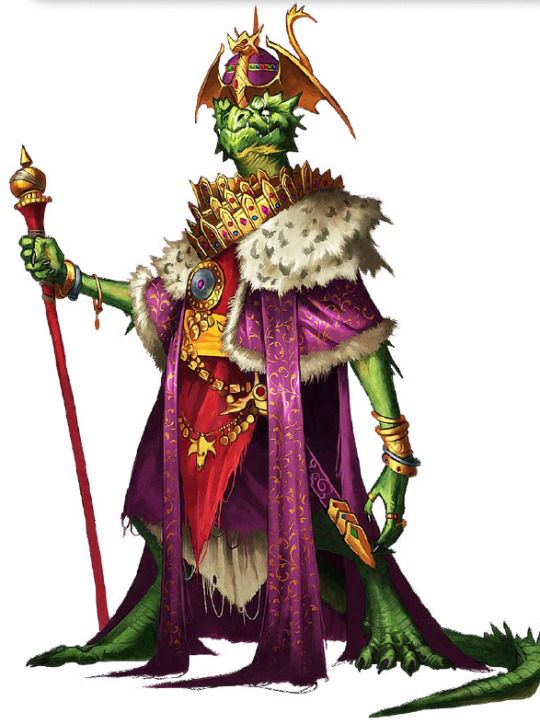
Kobold, King
Wrapped in tattered finery and draped in silver and gold jewelry, the king kobold sits on a throne, surrounded by an assortment of grisly traps and weaponry. Its crown, a garish mass of precious metals, adds weight to its boastful decrees.
Small humanoid (kobold), lawful neutral
Armor Class 15 (18 with mage armor) Hit Points 112 (25d6 + 25) Speed 30 ft.
STR: 8 (-1) DEX: 20 (+5) CON: 12 (+1) INT: 14 (+2) WIS: 14 (+2) CHA: 15 (+2)
Saving Throws Dexterity +8, Intelligence +5 Skills Deception +5, Insight +8, Intimidation +8, Persuasion +8 Senses darkvision 60 ft., passive Perception 12 Languages Common, Draconic Challenge 6 (2,300 XP)
Special Traits
Cunning Action. On each of its turns, the king kobold can use a bonus action to take the Dash, Disengage, or Hide action.
Evasion. If the king kobold is subjected to an effect that allows it to make a Dexterity saving throw to take only half damage, the king instead takes no damage if it succeeds on the saving throw, and only half damage if it fails.
Pack Tactics. The king has advantage on attack rolls against a creature if at least one of the king’s allies is within 5 feet of the creature and the ally isn’t incapacitated.
Sneak Attack (1/Turn). The king kobold deals an extra 14 (4d6) damage when it hits a target with a weapon attack and has advantage on the attack roll, or when the target is within 5 feet of an ally of the king that isn’t incapacitated and the king doesn’t have disadvantage on the attack roll.
Sunlight Sensitivity. While in sunlight, the king has disadvantage on attack rolls and on Wisdom (Perception) checks that rely on sight.
Spellcasting. The king kobold is a 4th-level spellcaster. Its spellcasting ability is Intelligence (spell save DC 13, +5 to hit with spell attacks). It has the following wizard spells prepared:
Cantrips (at will): fire bolt, mage hand, minor illusion, poison spray
1st level (4 slots): alarm, grease, mage armor
2nd level (3 slots): alter self, hold person, invisibility
Actions
Multiattack. The king kobold makes two shortsword attacks.
Shortsword. Melee Weapon Attack: +8 to hit, reach 5 ft., one target. Hit: 8 (1d6 + 5) piercing damage.
Hand Crossbow. Ranged Weapon Attack: +8 to hit, range 30/120 ft., one target. Hit: 8 (1d6 + 5) piercing damage.
Reactions
Uncanny Dodge. The king kobold halves the damage from one attack that hits it. To do so, it must see the attacker.
About
Keen Nose for Politics. With considerable guile won by hard experience, a king kobold excels at subterfuge, sustains lucrative trade, and hones a keen eye for potential treachery. The king who rules for more than a few seasons has mastered the art of keeping itself safe through a combination of warriors paid well enough to be loyal, a constant campaign to root out enemies, and an abundance of traps, tricks, and contingencies should things go sour. However, security from threats above and below ground and wealth earned through trade are what truly maintain a king on its throne.
Eyes Everywhere. The condition of its warrens and outlying tribes that pay tribute occupy much of a king kobold’s time and energy. Tunnel-runners come and go in a constant stream from warren to warren to keep the king abreast of happenings in all of its holdings. A truly successful king may command fealty from a network of tribes stretching for miles.
Long Live the King. Unlike many tribal kobold chieftains, a king kobold leaves the fighting to its underlings whenever possible, except when doing so might weaken its hold on its territory. Few creatures are as ruthless as a threatened king, and the king will not hesitate to sacrifice everything and everyone to escape and live to fight another day.
Section 15: Copyright Notice: Creature Codex. © 2018 Open Design LLC; Authors Wolfgang Baur, Dan Dillon, Richard Green, James Haeck, Chris Harris, Jeremy Hochhalter, James Introcaso, Chris Lockey, Shawn Merwin, and Jon Sawatsky.
15 notes
·
View notes
Text
Marketplace Roundup for November 5th, 2020

Alien Archive is back for the third time! Starfinder Alien Archive 3 is packed with creatures like starmetal dragons and the spiral-winged irokirois to living holograms and body-snatching flayer leeches. The creatures in this codex will challenge adventurers no matter what strange worlds they're exploring. Player rules for a variety of species let players not only fight aliens but be them!
The Roll20 Conversion lets you play with less prep and contains over 100 new stat blocks with in-app drag-and-drop and 70 new items including weapons, magic items, and water vehicles! From shimmer stone staves to water bears, Alien Archive 3 has you covered.

Here are some of our favorites from our Marketplace Creators this week:
Mage Heist by Dan DiPietro | $5.99
Taverns & Inns by Shawn Conlin | $9.99
Grimoire: World and Art Bundle by Evil Hat Productions | $9.99
Tasha's Cauldron of Everything (PRE-ORDER) by Wizards of the Coast | $49.95
As a reminder, we’re matching donations to Code2040, “a nonprofit activating, connecting and mobilizing the largest racial equity community in tech to dismantle the structural barriers that prevent the full participation and leadership of Black and Latinx technologists in the innovation economy.” Learn more and donate through our Tiltify campaign here: http://roll20.io/Tiltify-Code2040
0 notes